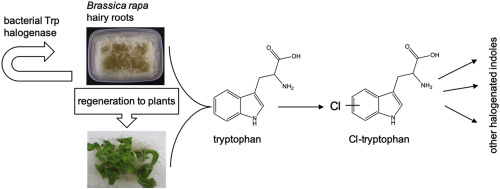当前位置:
X-MOL 学术
›
Phytochemistry
›
论文详情
Our official English website, www.x-mol.net, welcomes your feedback! (Note: you will need to create a separate account there.)
Hairy root transformation of Brassica rapa with bacterial halogenase genes and regeneration to adult plants to modify production of indolic compounds
Phytochemistry ( IF 3.8 ) Pub Date : 2020-07-01 , DOI: 10.1016/j.phytochem.2020.112371 Madeleine Neumann 1 , Swantje Prahl 2 , Lorenzo Caputi 3 , Lionel Hill 4 , Baldeep Kular 4 , Antje Walter 1 , Eugenio P Patallo 5 , Daniela Milbredt 5 , Alfredo Aires 6 , Maria Schöpe 2 , Sarah O'Connor 3 , Karl-Heinz van Pée 5 , Jutta Ludwig-Müller 1
Phytochemistry ( IF 3.8 ) Pub Date : 2020-07-01 , DOI: 10.1016/j.phytochem.2020.112371 Madeleine Neumann 1 , Swantje Prahl 2 , Lorenzo Caputi 3 , Lionel Hill 4 , Baldeep Kular 4 , Antje Walter 1 , Eugenio P Patallo 5 , Daniela Milbredt 5 , Alfredo Aires 6 , Maria Schöpe 2 , Sarah O'Connor 3 , Karl-Heinz van Pée 5 , Jutta Ludwig-Müller 1
Affiliation

|
During the last years halogenated compounds have drawn a lot of attention. Metabolites with one or more halogen atoms are often more active than their non-halogenated derivatives like indole-3-acetic acid (IAA) and 4-Cl-IAA. Within this work, bacterial flavin-dependent tryptophan halogenase genes were inserted into Brassica rapa ssp. pekinensis (Chinese cabbage) with the aim to produce novel halogenated indole compounds. It was investigated which tryptophan-derived indole metabolites, such as indole glucosinolates or potential degradation products can be synthesized by the transgenic root cultures. In vivo and in vitro activity of halogenases heterologously produced was shown and the production of chlorinated tryptophan in transgenic root lines was confirmed. Furthermore, chlorinated indole-3-acetonitrile (Cl-IAN) was detected. Other tryptophan-derived indole metabolites, such as IAA or indole glucosinolates were not found in the transgenic roots in a chlorinated form. The influence of altered growth conditions on the amount of produced chlorinated compounds was evaluated. We found an increase in Cl-IAN production at low temperatures (8 °C), but otherwise no significant changes were observed. Furthermore, we were able to regenerate the wild type and transgenic root cultures to adult plants, of which the latter still produced chlorinated metabolites. Therefore, we conclude that the genetic information had been stably integrated. The transgenic plants showed a slightly altered phenotype compared to plants grown from seeds since they also still expressed the rol genes. By this approach we were able to generate various stably transformed plant materials from which it was possible to isolate chlorinated tryptophan and Cl-IAN.
中文翻译:

用细菌卤化酶基因转化芸苔的毛根并再生成成年植物以改变吲哚化合物的生产
在过去的几年中,卤代化合物引起了很多关注。具有一个或多个卤原子的代谢物通常比它们的非卤代衍生物(如吲哚-3-乙酸 (IAA) 和 4-Cl-IAA)更具活性。在这项工作中,细菌黄素依赖性色氨酸卤化酶基因被插入到芸苔属植物中。pekinensis(大白菜),旨在生产新型卤代吲哚化合物。研究了转基因根培养物可以合成哪些色氨酸衍生的吲哚代谢物,例如吲哚硫代葡萄糖苷或潜在的降解产物。显示了异源产生的卤化酶的体内和体外活性,并证实了转基因根系中氯化色氨酸的产生。此外,还检测到氯化吲哚-3-乙腈 (Cl-IAN)。其他色氨酸衍生的吲哚代谢物,如 IAA 或吲哚硫代葡萄糖苷,未在转基因根中以氯化形式存在。评估了改变的生长条件对产生的氯化化合物的量的影响。我们发现低温 (8 °C) 下 Cl-IAN 产量增加,但在其他方面没有观察到显着变化。此外,我们能够将野生型和转基因根培养物再生为成年植物,后者仍然产生氯化代谢物。因此,我们得出结论,遗传信息已经稳定整合。与从种子生长的植物相比,转基因植物显示出略微改变的表型,因为它们仍然表达 rol 基因。
更新日期:2020-07-01
中文翻译:

用细菌卤化酶基因转化芸苔的毛根并再生成成年植物以改变吲哚化合物的生产
在过去的几年中,卤代化合物引起了很多关注。具有一个或多个卤原子的代谢物通常比它们的非卤代衍生物(如吲哚-3-乙酸 (IAA) 和 4-Cl-IAA)更具活性。在这项工作中,细菌黄素依赖性色氨酸卤化酶基因被插入到芸苔属植物中。pekinensis(大白菜),旨在生产新型卤代吲哚化合物。研究了转基因根培养物可以合成哪些色氨酸衍生的吲哚代谢物,例如吲哚硫代葡萄糖苷或潜在的降解产物。显示了异源产生的卤化酶的体内和体外活性,并证实了转基因根系中氯化色氨酸的产生。此外,还检测到氯化吲哚-3-乙腈 (Cl-IAN)。其他色氨酸衍生的吲哚代谢物,如 IAA 或吲哚硫代葡萄糖苷,未在转基因根中以氯化形式存在。评估了改变的生长条件对产生的氯化化合物的量的影响。我们发现低温 (8 °C) 下 Cl-IAN 产量增加,但在其他方面没有观察到显着变化。此外,我们能够将野生型和转基因根培养物再生为成年植物,后者仍然产生氯化代谢物。因此,我们得出结论,遗传信息已经稳定整合。与从种子生长的植物相比,转基因植物显示出略微改变的表型,因为它们仍然表达 rol 基因。


























 京公网安备 11010802027423号
京公网安备 11010802027423号